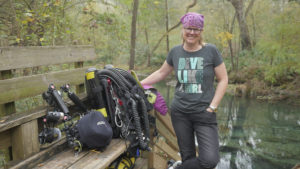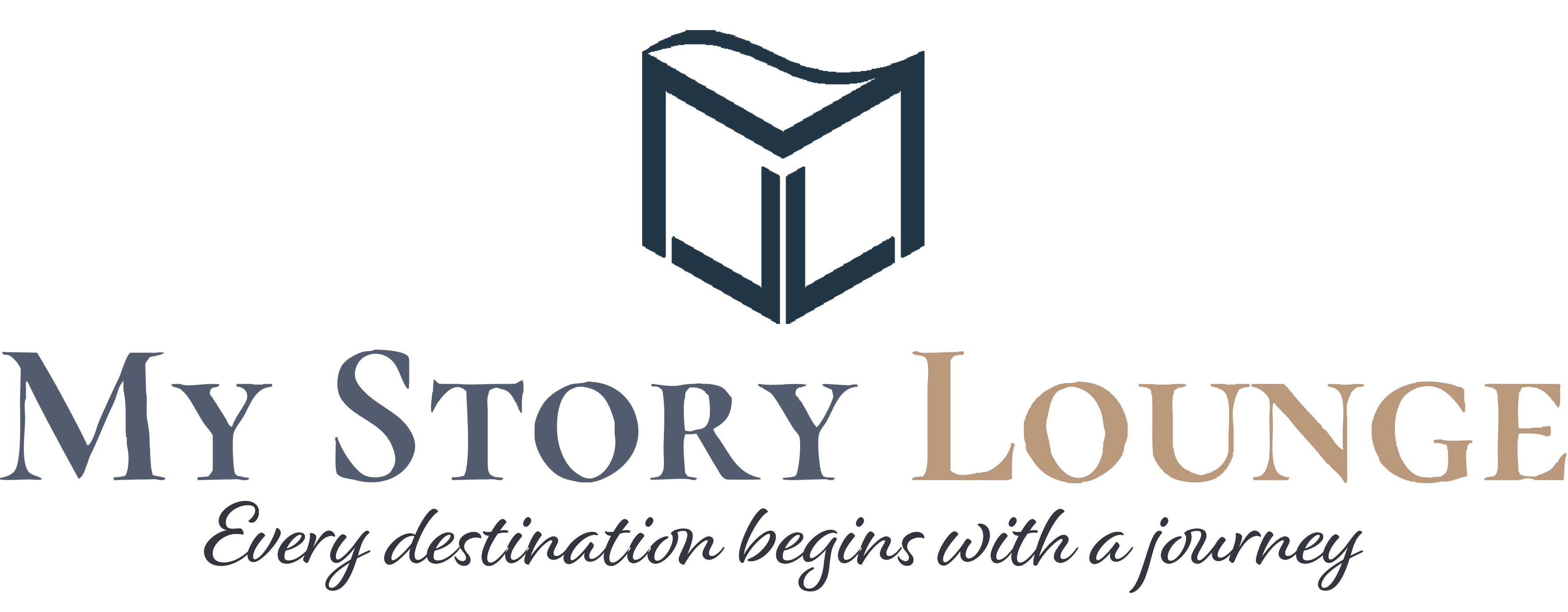An Invitation Into The Unknown – Jill Heinerth
Share

“Some people are repelled by the darkness of an underwater cave, but for me it’s an invitation into the unknown”
These are the words Jill Heinerth, a Canadian world-renowned cave diver and explorer, uses to describe her passion and profession. More than that, she is also a writer, photographer and an award-winning film-maker. Her accolades include being named a “Living Legend” by Sport Diver Magazine and getting inducted into the exclusive New York Explorers Club.
In the film-making space, Heinerth has worked on a number of TV series for PBS, National Geographic Channel and the BBC, consulted on movies for directors including James Cameron, written several books and produced documentaries. Furthermore, she advises on training programmes for diving agencies, publishes photojournalism in a range of magazines and speaks around the world.
In 1998, Heinerth was part of the team that made the first 3D map of an underwater cave. She became the first person to dive the ice caves of Antarctica, going further into an underwater cave system than any woman has ever gone before.
Whether we are intrigued or petrified at the prospect of cave-diving, we can’t help but marvel at the adventurous spirit of this brave woman, whose job it is to explore near-freezing waterways under a few hundred feet of ice; and travel to places so remote that just getting there is treacherous.

EARLY LIFE
Tell us more about your family background and share with us on what it was like growing up.
I grew up in a small town in Canada, the daughter of an engineer and English teacher. My Mom gave up her early career aspirations to raise our family. We lived frugally and loved outdoor adventures, picnics, hikes, and canoeing trips.
How did your upbringing shape the person you are today?
My parents instilled in me a love of learning, encouraging me to pursue my interests with passion and integrity. I did not feel like there were any bounds to what was possible for me. They taught me that I could do anything I wanted if I worked hard.
How would you sum up your childhood?
I was adventurous, curious and loved learning.

JOURNEY
How did you get started as an underwater explorer and filmmaker respectively?
I studied Fine Arts at York University in Toronto and worked as a graphic designer at the same time. I also taught scuba-diving in the evenings and on weekends. I was drawn to scuba-diving and decided to find a way to be a creative professional in the underwater world.
As much as I loved being a graphic designer, working indoors felt stifling to me. I saw a career path in becoming a full-time diver and thus I decided to sell everything I owned in Toronto, Canada, and moved to the Cayman Islands to pursue my love for diving.
To support myself financially, I also assembled a hybrid work-life that included writing, photography, cinematography, consulting, instruction, and public speaking.
What were some significant challenges you faced, lessons learnt and hard decisions you had to make along the way?
When I first started out, I faced both sexism and unintentional biases while working in a male-dominated vocation. It was fairly difficult to jumpstart a career as an independent diving professional, and I always had to find new ways to sustain my income streams.
I had discovered that when someone is financially challenged, not being busy enough or being too busy, can both be stressful situations! So I built my confidence, patience, and tenacity. If one income stream wasn’t producing, I pitched new ideas to secure paid projects and developed lasting income streams from creative assets that I produced.
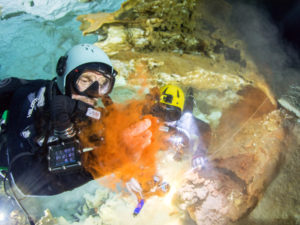
Jill photographs the National Geographic team in Abaco, Bahamas.
Share with us some experiences/stories that you think are significant to your journey so far.
As a young woman who was quickly rising to the top in the world of professional cave-diving, I was subjected to online bullies. Nasty commentary, death threats and cruel insults were just some of the attacks directed at me from people whom I have never even met before in my life.
At one point, a man sent me a package with body bags in it. He told me to “clean up the cave” after my project, insinuating that someone would die under my watch. I was deeply shaken.
At first, I felt deeply hurt by those personal attacks but then I realised that the reason they did that was more about themselves rather than personally targeting me.
The truth is that cave diving is incredibly dangerous. I have known more than 100 people that have lost their lives in cave diving and technical diving accidents. These were friends and colleagues. Each loss takes its psychological toll on me.
I have since learned that all I can do is bring my best self to work every day. My desire is to live with integrity and mentor the next generation of cave-divers with the same dedication to safety that I have learnt for over 30 years in the business.
Some of my early diving projects and expeditions were catalysts for great lessons. They include being trapped inside an iceberg in Antarctica and recovering from severe injuries due to a deep-diving accident. Having said that, I felt that I have achieved things that I initially thought were impossible. In the end, I learned that we are all capable of much more than we can imagine.
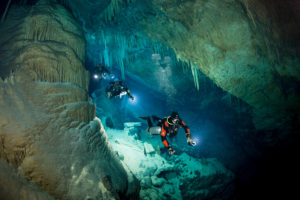
The search for deep caves in Bermuda, led Heinerth and her team to make the deepest manned dives in the island nation’s history. Photo: Jill Heinerth
ACHIEVEMENTS
Which achievements/milestones are you most proud of and why?
I am proud of being a Fellow of the International Scuba Diving Hall of Fame, Underwater Academy of Arts and Sciences, Women Divers Hall of Fame, and the Explorers Club, which awarded me with the ‘William Beebe Award’ for ocean exploration.
These were incredible milestones in my career, but the most special recognition of all – was being named the first Explorer-in-Residence of the Royal Canadian Geographical Society. With this platform, I have been able to reach tens of thousands of children around the world to conduct presentations and workshops that I hope can help them spark an interest in science, geography, and exploration.
I also take pride in completing two books so far, namely:
1) My memoir, ‘Into the planet’, which has been lauded by the Wall Street Journal, Oprah Magazine, and the New York Times.
2) My new children’s book, ‘The Aquanaut’, is a Blue Ribbon Selection for Dolly Parton’s Imagination Library. That program has helped to distribute close to 8000 copies to underprivileged kids.
What do you think are the key ingredients to your success?
They say that nobody will work harder for you than yourself. I know that to be true. Hard work, tenacity, and humility are important traits that I embrace.
Multi-tasking, learning new skills and being willing to do whatever needs to be done for a given situation, plays a significant part in my success too. I do my very best to be a team player to lead and manage people, no matter how difficult the role or how minor the task is. For example, I would not leave a sink full of dishes on a research boat for someone else to clean up. I also consider it to be important to contribute to the well-being of the team, knowing that we are all equals.
What lies ahead in terms of your goals and ambitions?
There are some very ambitious research and exploration initiatives as well as documentary and education programs that are in the pipeline. It includes diving in Canada’s longest underwater cave system and some delayed expeditions including documenting WWII shipwrecks off Newfoundland.
I am also working on a once-in-a-lifetime educational initiative that aims to teach people about ‘The Great Lakes’, which are the largest surface freshwater system on the Earth. Using exciting augmented reality technology, we are creating an immersive experience with global impact.
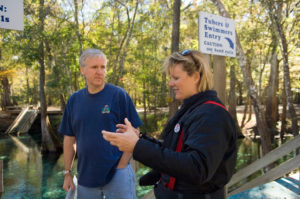
Jill Heinerth briefing James Cameron before his first cave dive. Photo: Jackie Windh
PERSONAL (LIFE)
What is your life motto if any?
I suppose “do unto others as you would have them do unto you,” is an important creed. I always try to put myself in someone else’s shoes. It is through recognition that empathy can solve the largest problems.
To you, what are the most important things in life?
I believe in continuous life-long learning and thus I am never bored.
Another aspect I find important is to take on risks in life and do the things that may seem terrifying. Don’t get me wrong, I am not fearless. But when I am scared, it is because I recognise that I am taking on a risk where I deeply care about the outcome.
Fear is a driver for exploration and discovery, so I will continue to take calculated risks in the interest of expanding my horizons and being part of important scientific discoveries that can make the world a better place.
What’s worth mentioning on your bucket list that you have not done?
If I had the funds, I would pursue training in an atmospheric diving suit to enable me to dive deep enough to reach places never documented before. I’d love to go to space to see the big blue marble of our Earth, but I still want to reach even more remote places on this planet. The ‘Exosuit’ (a one-piece atmosphere hard diving suit) could help me to document new species and lost cultural assets in the ocean’s greatest depths.
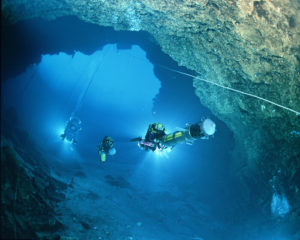
Jill Heinerth drives the Wakulla2 Digital Wapper on a 1997-98 project with the U.S. Deep Caving Team. On this project, the team created the first accurate 3D map of subterranean space and pushed the bounds of human performance.
Why do you do what you do? (What drives you everyday)
I love the challenge of pushing the boundaries of what we perceive as possible. It’s a joy to learn new skills and then apply that knowledge toward communicating about critical issues such as water literacy and climate change to people. My hope is that through my unique perspectives of the Earth from deep within the planet, people can get excited to learn more and become more aware about important global issues.
Who are the role models and influences in your life?
Dr. Sylvia Earle is a key influencer of mine. Me and my colleagues refer to her as “Her Deepness!” But seriously, she is an inspiration who shares the truth about difficult issues while empowering and inspiring others to act.
What are some things that many people don’t know about you?
I love cycling and once rode my bicycle on a 7000 km journey across the country, unsupported. Few people know that I am also a painter.
What are some life lessons worth mentioning?
Chase fear or you will spend your life running from it.
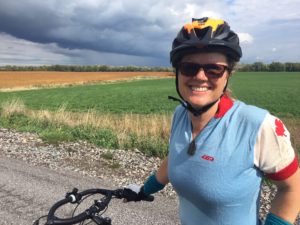
VIEWPOINTS
Do you think females are underrepresented in underwater exploring professionally?
Yes, absolutely. Diving, exploring and filmmaking are all male-dominated fields. The good news is, that is slowly changing. When I first launched my career, there were few women in any of those areas.
As more female talents entered the sectors mentioned, more women could better visualise themselves in these roles. There is no reason why women can’t excel in all these activities. Moreover, women make great team players. We are extremely resilient in difficult situations and given the opportunity, can rise to achieve our full potential.
When I started diving, there were many barriers to overcome. Beyond sexism and unintentional bias, technical diving gear designed to fit a woman simply did not exist. That is not merely an issue of appearance. When diving equipment doesn’t fit, it is a safety and comfort issue.
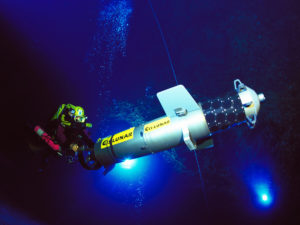
Jill drives the 3D Digital Wall Mapper at Wakulla Springs during the Wakulla2 Project. Photo: Wes Skiles, Courtesy of the U.S. Deep Caving Team Inc.
You acknowledged that underwater exploring is a risky endeavour and said it yourself that “more people have died exploring underwater caves than climbing Mt. Everest”. How should individuals with little to no experience weigh the risks vs rewards even before they decide to embark on such diving trips?
Risk assessment and acceptance is a balancing act. A poor decision at work could cost me my life, but if I don’t take risks, I will not make any new discoveries – for myself or for humanity. Whether you are a diver or a salesperson, taking risks leads to an opportunity.
Sure, I might fail. But that failure is never a negative in my mind. Failure is simply ‘discovery learning’. If I have taken steps to mitigate the risks, then I will become better each time at minimising my downside without affecting my pursuit of new discoveries or opportunities.
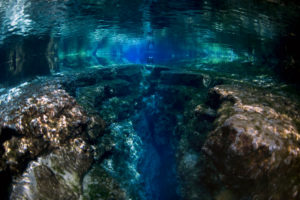
Little Devil Spring. Photo: Jill Heinerth
What advice would you give to aspiring underwater explorers who are looking to turn their passion into a career?
Work hard. There are some classes and mentors that help you learn new skills, but understand that your path to becoming a world-class explorer is personal. You will need to adopt a tenacious spirit, set learning objectives and master your craft by being hands-on – education can only take you so far, the rest requires you to learn through practical experiences. Look forward a decade to where you want to be, then plot a relentless path in that direction.
How does your general view of the world differ from someone who does not have the privilege to experience firsthand another facet of the like you do?
I don’t sweat the ‘small stuff’ or get embroiled in the drama of personal opinions. I love a diversity of viewpoints, recognizing that getting outside of my own head and outside of my comfort zone yields new opportunities for collaborations.
